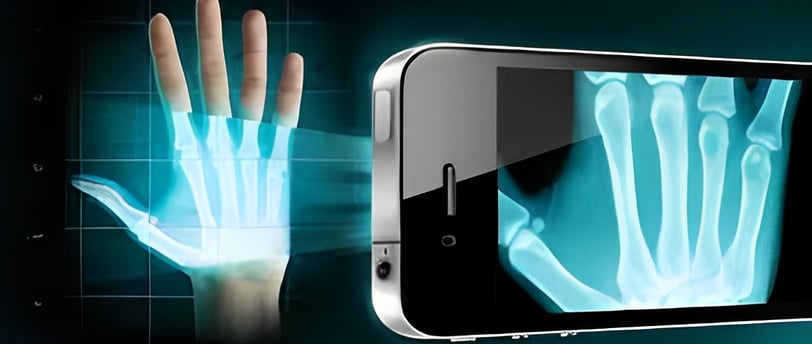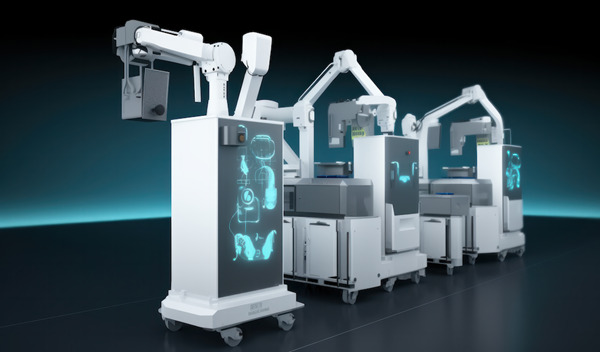Future Trends in Portable X-Ray Machines: Revolutionizing Healthcare on the Go
X-ray machines have long been essential for diagnosing injuries, detecting diseases, and monitoring health conditions. However, traditional X-ray machines are often bulky, immovable, and designed to be used only in hospitals or large medical facilities. But with the rise of portable X-ray machines, healthcare is undergoing a significant transformation, allowing for on-the-go diagnostics and improving patient care in a wide range of settings. In this blog, we’ll explore the future trends of portable X-ray machines and how these innovations are making healthcare more accessible, efficient, and convenient.
2/20/20254 min read


1. Compact and Lightweight Designs
The first trend we’re seeing is the growing demand for compact and lightweight portable X-ray machines. In the past, portable X-ray devices were bulky and difficult to transport. However, advancements in technology have made it possible to design machines that are significantly lighter, smaller, and easier to move around.
This shift in design allows healthcare providers to transport X-ray machines to various locations, whether it’s at a patient’s bedside, in rural areas, during emergencies, or in the field. These small devices can now be easily carried by a single person, enhancing mobility and accessibility.
2. Wireless and Battery-Powered Machines
Gone are the days when portable X-ray machines required cumbersome wires or constant connection to power outlets. The future of portable X-ray technology is wireless and battery-powered. With the advent of advanced battery technology, these machines can operate for longer periods without needing to be plugged in, making them even more convenient for fieldwork and emergency situations.
Wireless communication also means that images can be transferred instantly to healthcare professionals via the cloud or hospital networks, ensuring quick diagnosis and faster decision-making.
3. Improved Image Quality
Portable X-ray machines have come a long way in terms of image resolution and quality. While older models may have produced images with lower resolution, modern portable X-rays now offer high-definition imaging that rivals their stationary counterparts. This is possible thanks to the integration of advanced digital imaging sensors, which capture detailed images in real time.
As these machines become more advanced, they are capable of providing clearer, more accurate images, allowing doctors to make better diagnoses even in remote locations where sophisticated imaging equipment may not be available.
4. Artificial Intelligence (AI) Integration
Artificial Intelligence (AI) is increasingly being integrated into portable X-ray machines to improve diagnostic accuracy and workflow. AI-powered algorithms can automatically analyze X-ray images, helping doctors identify abnormalities such as fractures, tumors, or lung infections more quickly and with greater accuracy.
In the future, AI could be used to provide instant results, helping doctors make immediate decisions, particularly in emergency or remote settings where time is critical. This integration will also reduce human error, as AI can help detect subtle changes in images that might otherwise be missed by the human eye.
5. Cost Reduction and Affordability
Portable X-ray machines used to be prohibitively expensive for many smaller clinics, mobile units, or rural hospitals. However, as technology advances and manufacturing processes improve, the cost of these machines is steadily decreasing.
This trend makes portable X-ray systems more affordable and accessible to a broader range of healthcare providers. As a result, more hospitals, clinics, and even first responders can benefit from these advanced tools, improving healthcare delivery in underserved regions.
6. Telemedicine and Remote Diagnostics
Another exciting trend in the future of portable X-ray machines is the integration with telemedicine and remote diagnostic services. With the ability to capture high-quality X-ray images and send them electronically, healthcare professionals can now provide consultations and second opinions to patients in remote areas.
Doctors in larger hospitals or specialty centers can review X-ray images taken in rural or isolated locations, offering timely feedback to on-site medical staff. This collaboration helps overcome geographical barriers and improves access to quality care, especially in emergencies.
7. Point-of-Care (POC) Diagnostics
Point-of-care diagnostics is another growing trend in healthcare, and portable X-ray machines are playing a major role in this transformation. Point-of-care refers to the practice of diagnosing and treating patients at the location where they are receiving care, rather than sending them to a centralized diagnostic center.
Portable X-ray machines are ideal for point-of-care settings such as emergency rooms, ambulances, and home healthcare visits. The ability to take X-ray images directly at the patient’s bedside allows for quicker diagnoses and faster treatment decisions, ultimately improving patient outcomes.
8. Enhanced Durability for Harsh Environments
Portable X-ray machines are increasingly designed to withstand harsher environments. This trend is particularly important for military, emergency, and field settings, where equipment is subjected to rough handling and challenging conditions.
These machines are becoming more rugged and durable, with protective cases and materials that help them survive extreme temperatures, dust, and even water exposure. As a result, portable X-ray machines can be used in more diverse environments, including disaster relief areas, battlefields, and remote outposts.
9. Sustainability and Eco-Friendly Design
As the demand for portable X-ray machines increases, manufacturers are focusing more on sustainability. There’s growing interest in making these devices energy-efficient, using environmentally friendly materials, and reducing waste in their production and usage.
The shift toward greener manufacturing processes and energy-efficient machines means that portable X-ray technology is becoming more eco-friendly, aligning with the global push for sustainability in healthcare.




Reference Website Link:
GE Healthcare: Evolving Mobile X-Ray Technology
MedicalSearch: The Future of Mobile X-Ray Technology
Sprint Diagnostics: Future of X-ray Technology
Imaging Technology News: Top 10 Trends in Digital Radiography
https://www.itnonline.com/article/top-10-trends-digital-radiography?utm_source=chatgpt.com
Grand View Research: Portable and Point-of-Care Diagnostic Imaging Devices
Innovative
Contact Us
Service
xraybazar.com
© 2024. All rights reserved.
Address- Rajasthan, India
Gmail Id- xraybazaroffcial.com
Important Links
